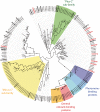A comparison of the olfactory gene repertoires of adults and larvae in the noctuid moth Spodoptera littoralis
- PMID: 23565215
- PMCID: PMC3614943
- DOI: 10.1371/journal.pone.0060263
A comparison of the olfactory gene repertoires of adults and larvae in the noctuid moth Spodoptera littoralis
Abstract
To better understand the olfactory mechanisms in a lepidopteran pest model species, the cotton leafworm Spodoptera littoralis, we have recently established a partial transcriptome from adult antennae. Here, we completed this transcriptome using next generation sequencing technologies, namely 454 and Illumina, on both adult antennae and larval tissues, including caterpillar antennae and maxillary palps. All sequences were assembled in 77,643 contigs. Their analysis greatly enriched the repertoire of chemosensory genes in this species, with a total of 57 candidate odorant-binding and chemosensory proteins, 47 olfactory receptors, 6 gustatory receptors and 17 ionotropic receptors. Using RT-PCR, we conducted the first exhaustive comparison of olfactory gene expression between larvae and adults in a lepidopteran species. All the 127 candidate olfactory genes were profiled for expression in male and female adult antennae and in caterpillar antennae and maxillary palps. We found that caterpillars expressed a smaller set of olfactory genes than adults, with a large overlap between these two developmental stages. Two binding proteins appeared to be larvae-specific and two others were adult-specific. Interestingly, comparison between caterpillar antennae and maxillary palps revealed numerous organ-specific transcripts, suggesting the complementary involvement of these two organs in larval chemosensory detection. Adult males and females shared the same set of olfactory transcripts, except two male-specific candidate pheromone receptors, two male-specific and two female-specific odorant-binding proteins. This study identified transcripts that may be important for sex-specific or developmental stage-specific chemosensory behaviors.
Conflict of interest statement
Figures





Similar articles
-
An Expressed Sequence Tag collection from the male antennae of the Noctuid moth Spodoptera littoralis: a resource for olfactory and pheromone detection research.BMC Genomics. 2011 Jan 29;12:86. doi: 10.1186/1471-2164-12-86. BMC Genomics. 2011. PMID: 21276261 Free PMC article.
-
Candidate chemosensory genes in female antennae of the noctuid moth Spodoptera littoralis.Int J Biol Sci. 2012;8(7):1036-50. doi: 10.7150/ijbs.4469. Epub 2012 Aug 10. Int J Biol Sci. 2012. PMID: 22904672 Free PMC article.
-
Identification and characterization of chemosensory genes in the antennal transcriptome of Spodoptera exigua.Comp Biochem Physiol Part D Genomics Proteomics. 2018 Sep;27:54-65. doi: 10.1016/j.cbd.2018.05.001. Epub 2018 May 7. Comp Biochem Physiol Part D Genomics Proteomics. 2018. PMID: 29787920
-
Transcriptome Analysis of Gene Families Involved in Chemosensory Function in Spodoptera littoralis (Lepidoptera: Noctuidae).BMC Genomics. 2019 May 28;20(1):428. doi: 10.1186/s12864-019-5815-x. BMC Genomics. 2019. PMID: 31138111 Free PMC article.
-
Identification and Characterization of Candidate Chemosensory Gene Families from Spodoptera exigua Developmental Transcriptomes.Int J Biol Sci. 2015 Jul 15;11(9):1036-48. doi: 10.7150/ijbs.12020. eCollection 2015. Int J Biol Sci. 2015. PMID: 26221071 Free PMC article.
Cited by
-
Stage-specific expression of an odorant receptor underlies olfactory behavioral plasticity in Spodoptera littoralis larvae.BMC Biol. 2021 Oct 28;19(1):231. doi: 10.1186/s12915-021-01159-1. BMC Biol. 2021. PMID: 34706739 Free PMC article.
-
Identification of candidate chemosensory genes in Mythimna separata by transcriptomic analysis.BMC Genomics. 2018 Jul 4;19(1):518. doi: 10.1186/s12864-018-4898-0. BMC Genomics. 2018. PMID: 29973137 Free PMC article.
-
De novo transcriptome assembly for a non-model species, the blood-sucking bug Triatoma brasiliensis, a vector of Chagas disease.Genetica. 2015 Apr;143(2):225-39. doi: 10.1007/s10709-014-9790-5. Epub 2014 Sep 19. Genetica. 2015. PMID: 25233990
-
Identification and tissue distribution of chemosensory protein and odorant binding protein genes in Tropidothorax elegans Distant (Hemiptera: Lygaeidae).Sci Rep. 2018 May 17;8(1):7803. doi: 10.1038/s41598-018-26137-6. Sci Rep. 2018. PMID: 29773848 Free PMC article.
-
Characterization of the Adult Head Transcriptome and Identification of Migration and Olfaction Genes in the Oriental Armyworm Mythimna separate.Sci Rep. 2017 May 24;7(1):2324. doi: 10.1038/s41598-017-02513-6. Sci Rep. 2017. PMID: 28539591 Free PMC article.
References
-
- Kreher SA, Kwon JY, Carlson JR (2005) The molecular basis of odor coding in the Drosophila larva. Neuron 46: 445–456. - PubMed
-
- Tanaka K, Uda Y, Ono Y, Nakagawa T, Suwa M, et al. (2009) Highly selective tuning of a silkworm olfactory receptor to a key mulberry leaf volatile. Curr Biol 19: 881–890. - PubMed
-
- Rutzler M, Zwiebel L (2005) Molecular biology of insect olfaction:recent progress and conceptual models. J Comp Physiol A Neuroethol Sens Neural Behav Physiol 191: 777–790. - PubMed
-
- Vogt RG (2003) Biochemical diversity of odor detection:OBPs, ODEs and SNMPs. In: Blomquist GJ, Vogt RG, editors. Insect Pheromone Biochemistry and Molecular Biology: Elsevier Academic Press. pp. 391–445.
MeSH terms
LinkOut - more resources
Full Text Sources
Other Literature Sources

